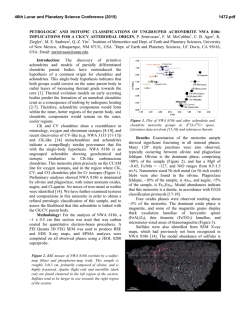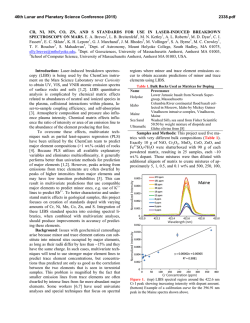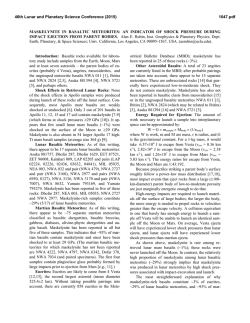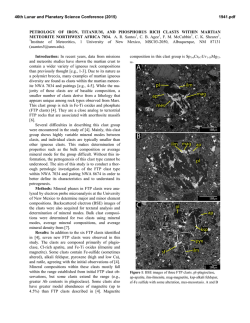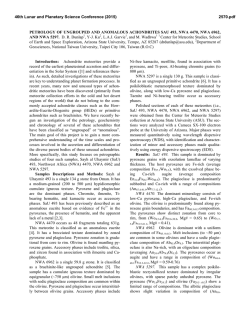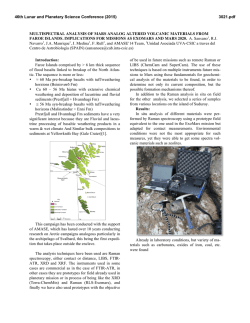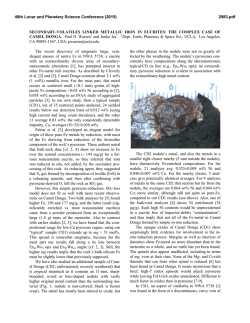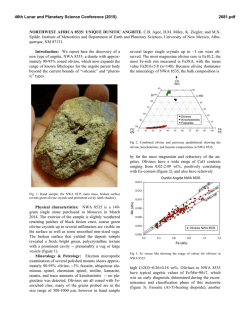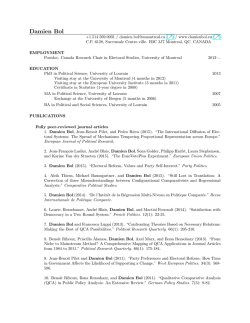
2232
46th Lunar and Planetary Science Conference (2015) 2232.pdf LASER INDUCED BREAKDOWN SPECTROSCOPY SAMPLING IN MARTIAN POLYMICT BRECCIA NORTHWEST AFRICA 7034. S. R. Gordon1, H. E. Newsom1, S. Clegg2, M. D. Dyar3, and C. B. Agee1, 1Institute of Meteoritics, Univ. New Mexico, Albuquerque, NM 87131 ([email protected]), 2Los Alamos National Laboratory (LANL), Los Alamos, NM, 3Department of Astronomy, Mount Holyoke College, South Hadley, MA, USA. Introduction: The ChemCam instrument on board the Mars Science Laboratory (MSL) Curiosity rover uses laser induced breakdown spectroscopy (LIBS) to determine the chemical composition of rock and soil targets in Gale crater, Mars. The 1064 nm laser with a spot size on the scale of ~350 microns can be shot in grids, called rasters, to examine many locations and determine an average composition for each target [1]. The number of LIBS spectra needed to calculate an accurate average rock composition varies by the grain size and heterogeneity of each target. A study by [2] used modeling to determine the number of LIBS observations needed to give an accurate bulk composition of a heterogeneous target based on the spot size/grain size ratio. This study is replicated here using a martian heterogenous hand sample, basaltic breccia Northwest Africa (NWA) 7034. NWA 7034 has a bulk composition similar to the martian crust [3] and includes clasts of varying compositions ranging in size on the order of hundreds of microns to tens of mm [4]. The principals from [2] are used to perform a semi-quantitative experiment using energy dispersive spectroscopy (EDS) element maps of the meteorite to determine the number of LIBS observations needed to give accurate clast and bulk compositions for this sample. The LIBSSIM program used in [2] is also used to test the sampling limits needed to accurately analyze a heterogenous sample using NWA 7034 as a basis for a theoretical model. Methods: Qualitative Study The sample used in this study is a polished, carbon coated, saw cut slab of NWA 7034 that had already been analyzed by LIBS in ten locaitons; thus, ten LIBS pits are visible on the surface of the sample. EDS images of NWA 7034 were created using the JEOL JSM 5800LV scanning electron microscope (SEM) at the University of New Mexico using a 30 kV accelerating voltage, 32 nA beam current and 150x magnification. Images of Si, Ti, Al, Fe, Mg, Ca, Na, and K were created along with a backscattered electron (BSE) image. Pixel intensity corresponds to the relative concentration of the element in each pixel. Relative changes in elemental composition were measured on the scale of a LIBS spot size across the bulk matrix and within two basaltic clasts in the meteorite using the ImageJ program. The average pixel intensities and their standard deviations were then compared to determine how many LIBS observations would give statistically different results among the matrix and basaltic clasts in the meteorite. The results of the Mg imaging and analysis process are presented in this abstract. Figure 1. Backscattered electron (BSE) image of the NWA 7034 sample used in this study. The lower right corner of the sample has been cut off due to instrument limitations and sample size. EDS analysis points for the bulk matrix are shown in a grid on the left side of the sample. Two clasts (outlined in white dashed curves) and their EDS analysis points are shown on the bottom right of the sample. Areas discussed in Figures 2 and 3 are outlined in yellow dotted boxes. Quantitative Study The methods outlined in the LIBSSIM Research Version User Guide (http://mtholyoke.edu/~pdobosh/libssim) and the bulk mineralogy of NWA 7034 reported in the text of [3] were used to simulate the matrix of the meteorite sample. In the program, each color in the simulation grid represents a different mineral input by the user. The pixel counts of theoretical LIBS observations are translated to oxide weight percentages at random locations on the grid. For the matrix simulation, a grain size of 5 pixels (correlating to 50 microns) and a beam size of 35 pixels (350 microns) were chosen to represent the average fine-grained matrix and LIBS spot sizes. Ten random observation points were taken inside the grid and the average oxide percentages at those locations were compared to the bulk composition of NWA 7034 reported in the supplemental materials of [3]. Qualitative Results: Bulk matrix composition. A 3x4 grid of analysis locations was created on the Mg map for NWA 7034. Each rectangular analysis area spans the LIBS spot size seen on the surface of the sample. The average pixel intensity of each analysis location was measured as a proxy of the average Mg composition that would be measured by a LIBS analy- 46th Lunar and Planetary Science Conference (2015) sis point in that location. The average intensity of the grid was calculated to be 22.5 and the standard deviation is 0.4. 2232.pdf cept FeO with average values still within 1-σ, suggesting more than ten observation points would give more precise oxide composition values. The decrease in standard deviation is greater than 5% for SiO2, Al2O3, TiO2, Fe2O3, CaO, and Na2O when the number of observations is increased from 10 to 20. A further increase to 30 LIBS observation points shows a greater decrease in all oxide standard deviations except FeO, MgO, and K2O. Figure 2. Magnesium EDS image overlain with EDS analysis locations on the matrix. See Figure 1 for scale. Individual clast compositions. Twelve analyses of two basaltic clasts were made on the Mg EDS image as shown in Figure 3. The average intensity of each rectangular location was recorded, and the average and standard deviation of the six observations for each clast were then compared. For the clast to the left in the image, the average intensity is 20.2 with a standard deviation of 0.3. For the clast to the right in the image, the average Mg pixel intensity is 24.7 with a standard deviation of 0.7. Figure 3. Magnesium EDS image overlain with EDS analysis locations on two basaltic clasts, outlined in the dashed white lines. See Figure 1 for scale. Quantitative Results: The LIBSSIM grid simulation of NWA 7034 matrix gave similar totals to the bulk composition reported in the supplemental materials of [3] within 1-σ for Al2O3, Na2O, and K2O and within 2-σ for SiO2, FeO, and MgO. TiO2 and CaO were not similar to the reported values within 2-σ; thus, they will not be included in the discussion. The 10-location theoretical LIBS observation done by LIBSSIM program shows a reliable bulk composition for the simulated NWA 7034 matrix. This supports the conclusions of [2] that when the grain size of a sample is smaller than the beam size, an accurate analysis can be taken with just ten LIBS locations. Increasing the number of observations from 10 to 20 decreased the standard deviation of all the oxides ex- Figure 4. LIBSSIM grid simulation of NWA 7034 bulk matrix using mineralogy given in [3] and an average grain size of 50 microns. Each colored square represents one of the following different minerals: andesine, enstatite, ferrosilite, pigeonite, augite, magnetite, maghemite, anorthoclase. Black squares represent theoretical LIBS analysis locations. Conclusions: Qualitative Study The two clasts show a statistical difference when sampled in six different locations on each clast on the Mg element map. Additionally, compared to the average intensity of the section of matrix measured in this study, each area has statistically different measurements. Thus, the ChemCam testbed unit used to analyze this meteorite sample should be able to qualitatively distinguish between bulk matrix and clast compositions with fewer than ten observation points. Quantitative Study The LIBSSIM experiment using a simulated NWA 7034 matrix composition supported the results of the theoretical study in [2]. Further study is needed to determine the best number of LIBS analysis locations needed to precisely analyze the LIBSSIM simulation of NWA 7034. A study using LIBSSIM to recreate the clast compositions in this sample will also allow for further testing of the LIBSSIM program using NWA 7034 as a basis for simulation of heterogenous martian material. References: [1] Wiens, R. C. et al (2102) Space Sci. Rev., 170, 167-227. [2] McCanta, M. C. et al (2013) Plan. and Space Sci., 81, 48-54. [3] Agee, C. B. et al (2012) Science, 339, 780-785. [4] McCubbin, F. M. et al (2104) 77th Met. Soc. Meeting, #5099.
© Copyright 2025

